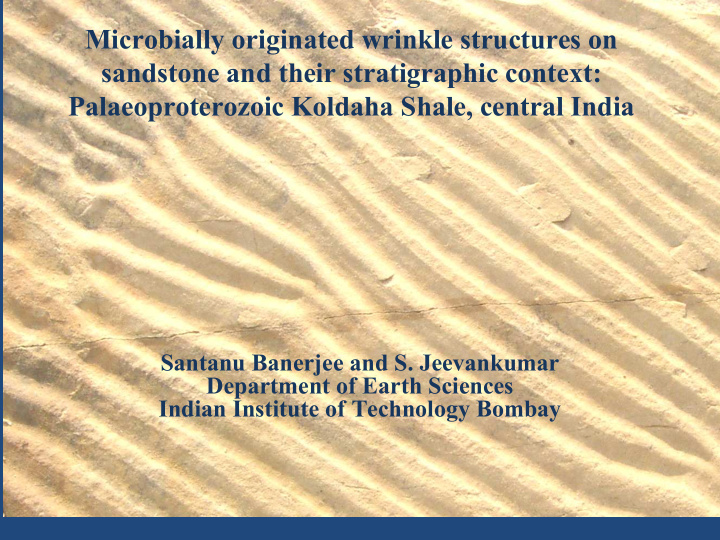



Microbially originated wrinkle structures on sandstone and their stratigraphic context: Palaeoproterozoic Koldaha Shale, central India Santanu Banerjee and S. Jeevankumar Department of Earth Sciences Indian Institute of Technology Bombay
Evolution of Life on Earth Evolution of life since its formation around 4500 Ma Paleozoic- Skeletal fossils appear 65 Ma Soft bodied metazoans appear before that Mesozoic- age of reptiles Microbes dominate the earlier part of earth’s history 225 Ma First record of microbe preserved in rocks- 3500 Ma Up to 540 Ma microbes were abundant 540 Ma This paper discusses about microbial life on sea floor around 1600 Ma Precambrian (4500- 540 Ma)
Stromatolites- earth’s oldest fossils Vindhyan, central India 1.7 Ga old Microbially originated structures in limestones Stromatolites are reported from rocks as old as 3500 Ma, so far > 500 reports, note cyclicity in this example
Stromatolites from shark bay world heritage site From www.aussieactionadventures.com Sedimentologists learn from modern- apply the concept in ancient rocks Hypersaline conditions favour microbial growth and form stromatolites
Search for microbial mats in modern clastic sediments in hypersaline environments Coastal areas west of Baroda
Study area- geological map - Map prepared by Geological Survey of India - The age of rocks of importance - 1.6 Ga - Oldest rocks 1.7 Ga, youngest around 0.6 Ga
Field investigations - Finding proper sections, mostly we find soil covers - Vertical sedimentary sections were studied in mines - Note variation in rock types - Document sedimentary features - Note the general trend in lithological variation - Interpretation of depositional environments - Interpretation of sea level fluctuations – rise or fall - Collect data for graphical representation of the section - Features on bedding surfaces cannot be seen
Search for bedding surface features - Search for features occurring on the bedding surfaces (red arrow) - Collect samples for laboratory investigations
Varieties of wrinkle structures- positive relief
Varieties of wrinkle structures – negative relief
Optical microscopic investigations 0.5 mm 0.1 mm Thin (<1 mm), dark cover at the top surface Wavy, crinkly carbonaceous fragments on magnification Suggest microbial growth soon after formation- do not confirm
Possible microbial filaments under SEM
Wrinkle varieties in vertical sedimentary succession Rocks becoming coarser upward Sea level is falling Finer wrinkles forming in the deeper part (50-200 m) of the sea Coarser wrinkles forming in the shallow seas (>10-50 m)
Conclusions • Discusses about microbial mat originated sedimentary structures in 1.6 Ga-old sandstones • Most previous reports of microbial structures are from limestone • Explains origin of wide range of wrinkle structures formed by microbe-sediment interaction • Discusses variation of the wrinkle structures in vertical sedimentary succession in response to sea level fall Thank you
Recommend
More recommend